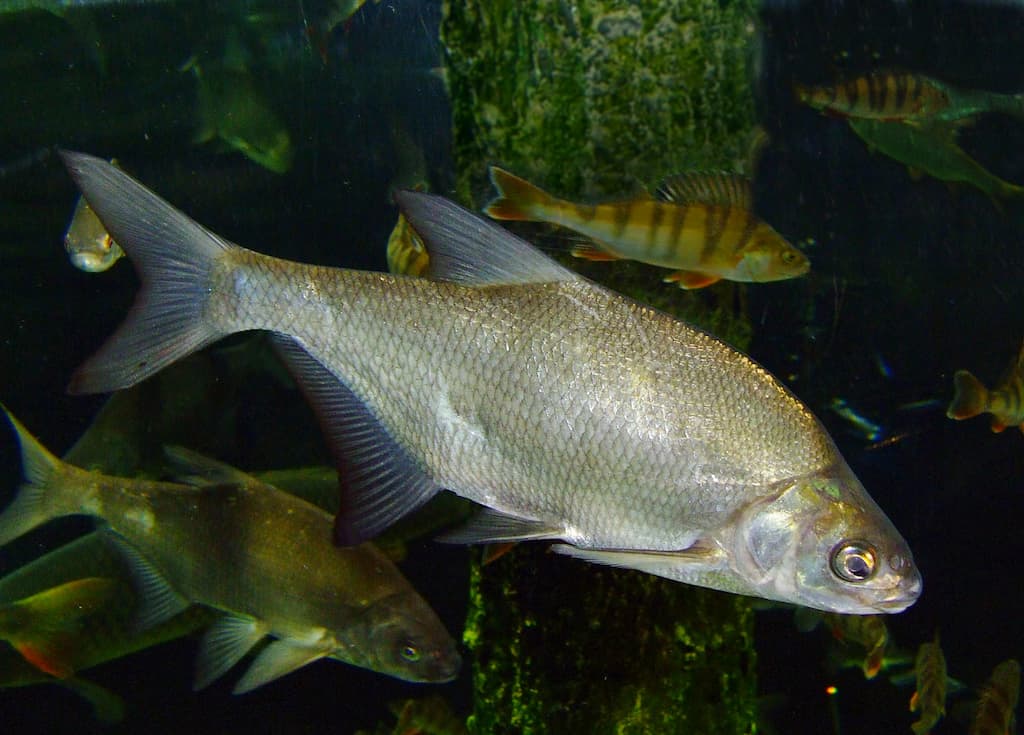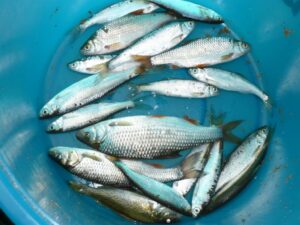Bottom feeder : Freshwater Bream (Abramis brama)

The Freshwater Bream, scientifically known as Abramis brama, is a distinct bottom-dwelling fish that holds a prominent position among anglers.
Alongside carp, the bream is among the most commonly sought-after freshwater fish. With its tendency to stir up the bottom, the Bream leaves characteristic marks on the water’s surface, revealing its presence to experienced anglers. In this article, we will explore the fascinating world of the Freshwater Bream, delving into its description, habitat, behaviour, and significance as a target species for anglers. You can discover the allure of this remarkable fish and gain insights into its habits, making your next fishing expedition fruitful.

What is a Freshwater Bream (Abramis brama)?
The Freshwater Bream (Abramis brama) is a fish species native to Europe and Asia. It is highly regarded among sport fishermen for its impressive size and strength. The freshwater bream is also prized for its delectable flesh and versatility in culinary applications.
Description of Freshwater Bream (Abramis brama)
The Freshwater Bream has a tall and laterally compressed body, allowing it to manoeuvre through aquatic vegetation effortlessly. As the fish matures, its back becomes more arched, adding to its distinctive appearance. The head and eyes of the freshwater bream are relatively small compared to its body size.
With a slightly protruding upper jaw, the mouth of the Freshwater Bream is obliquely oriented downward, indicating its preference for bottom feeding. The mouth is small, characterised by thick, protrusible lips and the absence of barbels.
One notable feature of the Freshwater Bream is its remarkably long anal fin, which consists of numerous soft rays. The dorsal fin is short and positioned posterior to the pelvic fins. The anal fin is deeply forked, with the upper lobe being faster than the lower lobe.
The Freshwater Bream’s overall appearance is bronze. Its back ranges from dark grey-green to olive with metallic green reflections. The fins are typically greyish-brown, occasionally appearing black. Young freshwater bream, often called “plaquettes,” exhibit a whitish or silvery colouration.
The fish’s lateral line is adorned with 51 to 60 large scales covered in abundant mucus. The typical size of a freshwater bream ranges from 30 to 50 cm and weighs between 0.5 and 2.5 kg. However, larger specimens can reach heights up to 80 cm and weigh as much as 7 kg. These fish have a lifespan of around 20 to 25 years.
| Class |
| Actinopterygii |
| Order |
| Cypriniformes |
| Family |
| Cyprinidae |
| Genus |
| Abramis |
| Species |
| A. brama |
| Binomial Name |
| Abramis brama (Linnaeus, 1758) |
Habitat and Lifestyle
The Freshwater Bream is widely distributed throughout central and western Europe, including the United Kingdom and Ireland. However, it is absent from Europe’s most northern and southern regions. This species prefers warm, calm waters such as lakes, canals, slow-flowing rivers, and ponds.
Being a gregarious fish, the Freshwater Bream forms impressive shoals and primarily feeds on the bottom, especially during warmer months. However, it remains active throughout the year.
In its juvenile stage, the Freshwater Bream primarily consumes algae, plankton, and small crustaceans. As it grows, its diet includes animalcules such as crustaceans, molluscs, insect larvae (especially Chironomidae and caddisfly larvae), and plant debris in the bottom mud. Larger specimens may even prey on fry and small fish.
The bream’s feeding behaviour involves using its protractile mouth to dig into the sediment and filter food particles. In food scarcity, the bream may resort to feeding at mid-water depths.
During spring, typically between April and June, when water temperatures reach 12 to 16°C, female bream deposits approximately 40,000 eggs per kilogram of body weight among aquatic plants. These yellowish eggs, measuring 1.5 to 2 mm in diameter, are adhesive and attach to submerged vegetation. The males fertilise the eggs and fiercely guard their territory until the fry hatch.
The growth rate of bream is relatively slow, with individuals reaching 10 cm in length after one year and attaining a weight of 3 kg after about ten years. It is worth noting that in areas where freshwater bream coexists with its close relative, the Silver Bream, hybridisation between the two species.
Interest of Freshwater Bream (Abramis brama) in Coarse Fishing
The flesh of the Freshwater Bream, also known as Abramis brama, is highly regarded for its delicate taste, making it a favourite among connoisseurs. However, it is important to note that this fish is notorious for its abundance of bones, which limits its culinary appeal.
From an angler’s perspective, the Freshwater Bream provides an exciting and entertaining fishing experience. When hooked, it puts up a spirited fight, making each fishing session enjoyable and memorable. The young Freshwater Bream is particularly valued as live bait due to its resilience and longevity, remaining active and lively for extended periods.
Anglers often target Freshwater Bream in coarse fishing, appreciating its challenge and rewards. The thrill of reeling in a substantial bream, coupled with the satisfaction of a successful catch, adds to the allure of this species. Whether a seasoned angler or a novice, pursuing freshwater bream can provide a fulfilling and enjoyable fishing adventure.
Conservation Status of Freshwater Bream (Abramis brama)
The Freshwater Bream, also known as Abramis brama, is classified as “Least Concern” (LC) in the IUCN Red List, indicating a widespread and abundant species. This categorisation suggests that the Freshwater Bream population is stable and not currently facing significant conservation threats. As a result, there is no immediate concern regarding the conservation status of the freshwater bream, providing reassurance for anglers and nature enthusiasts. However, monitoring their populations and habitats is essential to ensure their long-term sustainability in freshwater ecosystems.






